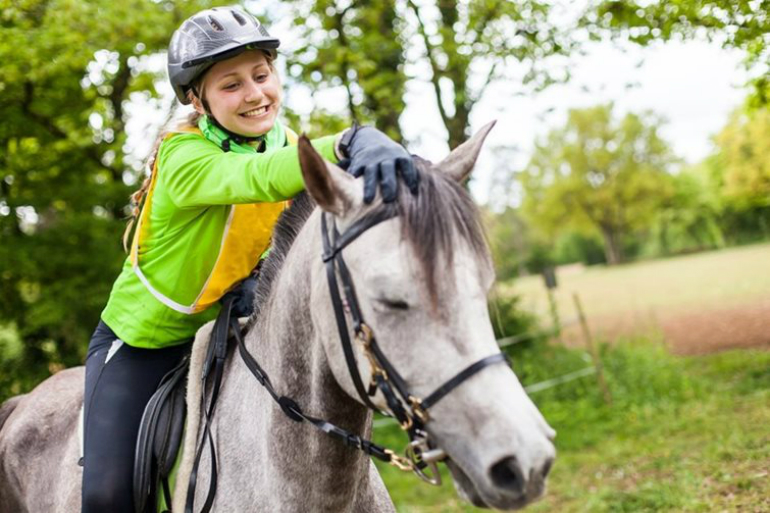Share:
Take it offline!
This Education in Motion resource is also available as a printable PDF.
Download PDF
Therapeutic horseback riding, a type of equine-assisted psychotherapy, is a form of social, physical and emotional therapy. In Ancient Greek, horseback riding was a well-known treatment for people who wished to rid themselves of physical or mental ailments. However, it wasn’t until 1900 that therapeutic horseback riding began to be used in Canada and the United States. Today in Australia, there are many practicing therapists that help promote emotional growth through the use of equine therapy which can be located via Equine Therapies Association of Australia.
Equine therapy is suitable for many different participants and is commonly used to develop and enrich physical, social and emotional wellbeing. The broad benefits of equine therapy have not gone unnoticed and equine therapy programs are increasingly sought after by people with disabilities. When participating in equine therapy, it’s imperative that professional equestrian therapists are on hand to coordinate and safely guide the session.
The Broad Benefits of Equine Therapy
Equine therapy helps build and improve your trust, self-awareness, motor skills, cognitive functions and emotional wellbeing. Equine programs can quicken rehabilitation and enhance the quality of life of people with mental, physical and sensory disabilities.
Successful equine therapy centres on the relationship between the participant and the horse. Psychological studies indicate that humans find it easier to build trusting relationships with horses because of the animal’s size and warmth. Horses are both calming and accustomed to human contact. Being in close contact with a horse’s warm body is a soothing experience for both parties, relaxing muscles fibres and stimulating circulatory processes.
When riding a horse, the animals’ movements triggers rhythmic pulses across the rider’s pelvic belt, legs and spine. Depending on the horse’s pace, the rider may or may not notice a pattern in their movement and momentum. This feeling is known as a ‘three-dimensional locomotive pattern’ and it triggers sensations of forward movement and powerful momentum.
From a physical perspective, equine therapy can improve muscle tone and increase your motor dexterity, core strength, balance and overall coordination. Equine therapy also has a wide array of psychological benefits for people with disabilities.
During equine therapy sessions, participants can have new experiences and begin connecting psychological reactions to appropriate physical and environmental stimuli. The act of riding and trusting a horse stimulates cognitive activity and fosters feelings of confidence. Equine therapy can be a method of building self-esteem, autonomy, communication skills and discipline.

Different Forms of Equine Therapy
Equine therapy is a strongly recommended form of therapy for a variety of disabilities, diseases and disorders. In particular, equine therapy is increasingly popular for people with Multiple Sclerosis, Spina Bifida, traumatological diseases or Autism. Regardless of your disability, your equine therapy program can be personalised to suit your physical and mental requirements. Some of the most popular equine therapy programs are:
- Instructional horseback riding: This is one of the most common equine therapy programs and it is regularly used to lay the groundwork for deeper interactions between a participant and horse. This connection building process can also include horse trainers, equestrian therapists and the participant’s family members. When these people are not included, this program is known as social equine therapy.
- Adapted horseback riding: This therapy program also functions as a type of adapted sport. Adapted horseback riding accommodates both recreational and professional horseback riders. To help the rider mount and dismount the horse, an adapted saddle design is fitted onto the horse before riding sessions. As a form of equine therapy, adapted horseback riding can actually provide deeper physical and mental stimulation than instructional horseback riding sessions.
- Hippotherapy: This equine therapy program simulates the motor and sensory sensation of movement and is designed for people with physical disabilities. The replicated movement is created by the gait of the horse and its effect on the participant’s pelvis.
- Therapeutic vaulting: This program combines horseback riding with advanced physical and gymnastic therapy. Vaulting a horse promotes a sense of accomplishment and improves the participant’s coordination, balance and strength.
Equine therapy is here to stay. The physical and psychological benefits of equine therapy programs are well documented and people with disabilities should not be discouraged by the evolving field. So do you have what it takes to try equine therapy?